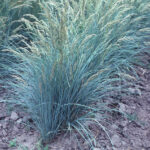Big Bluegrass
Poa secunda
Description générale
Big bluegrass est une graminée vivace, indigène, à saison fraîche, de longue durée de vie, qui mûrit tôt dans la saison de croissance. Elle fait partie de ce que l’on appelle le complexe de Sandberg bluegrass, qui comprend 8 espèces, dont Big bluegrass, Canby bluegrass, slender bluegrass, Alkali bluegrass, Nevada bluegrass, Sandberg bluegrass, et pine bluegrass. Les caractéristiques différenciantes au sein de ce complexe d’espèces varient souvent en fonction des facteurs environnementaux, rendant leur distinction très difficile. Big bluegrass est la plus robuste de cette collection et se distingue par sa grande production de fourrage et sa croissance précoce au printemps. Elle a été utilisée avec succès pour le resembrement des zones forestières brûlées et est utilisée par les oiseaux de gibier de montagne pour la nidification.
Type
Herbe indigène
Origine
Amérique du Nord
Longévité
La longévité des peuplements de pâturin à feuilles larges peut dépasser 30 ans. Cela est en partie dû à la dispersion des graines et à la capacité prolifique de cette espèce à se régénérer par ensemencement naturel.
Utilisation
Réhabilitation, pâturage, fourrage. Les oiseaux de gibier de montagne mangent les graines et utilisent Big bluegrass pour les zones de nidification. C’est également une espèce importante pour le resembrement des pâturages, la stabilisation des zones critiques, la réhabilitation des sols miniers et la revégétalisation des zones perturbées dans les forêts de trembles et de conifères. Les collections en Alaska ont été utilisées pour le contrôle de l’érosion, la réhabilitation et la restauration des communautés végétales indigènes.
Période d’utilisation optimale
Croît très tôt au printemps, jusqu’à 4 semaines plus tôt que le pâturin crêté. Cependant, le pâturage sur les peuplements nouvellement établis devrait être différé pendant 1 à 3 ans.
Récupération après utilisation
Considéré comme une espèce qui augmente après pâturage. Elle résiste très bien au piétinement car elle entre en dormance pendant l’été et l’automne.
En Colombie-Britannique, la production de fourrage varie, surtout en fonction des précipitations et de l’irrigation. Les zones recevant au moins 280 mm (11 po) de pluie peuvent produire de 630 à 1 360 kg/ha (562 à 1 214 lb/acre).
Appétence/Valeur nutritionnelle
Appétent pour le bétail au printemps et en automne, pour les cerfs au printemps, et pour les élans durant toutes les saisons. À mesure que le séchage progresse pendant l’été, la préférence du bétail diminue.
Précipitations annuelles min/max (mm)
255 mm / 610 mm
Tolérance à la sécheresse
Ne tolère pas la sécheresse aussi bien que d’autres graminées à saison fraîche.
Tolérance aux inondations
Bien qu’il pousse dans des conditions humides, il ne tolère pas les inondations précoces au printemps, le drainage insuffisant ou les nappes phréatiques élevées.
Rusticité hivernale
Classé avec une excellente tolérance au froid, mais cette évaluation provient du bassin inférieur de la Colombie-Britannique dans le nord-ouest pacifique des États-Unis, où les hivers sont plus doux que dans de nombreuses régions de la Colombie-Britannique.
Préférence de texture du sol
Se développe bien sur une variété de textures de sol, allant des sables modérément grossiers aux argiles denses.
Contrôle de l’érosion
Très faible à modérée.
Tolérance à la salinité
Faible tolérance.
Tolérance à l’acidité
Faible tolérance. Peut tolérer un pH jusqu’à 6.0.
Tolérance à l’alcalinité
Faible tolérance (jusqu’à pH 8.0). Non adapté au semis sur les plaines alcalines.
Graines par kg
2,000,000 graines/kg (926,000 graines/lb)
Mélanges suggérés
Peut être mélangé avec des fétuques indigènes, des pâturins et des seigles sauvages.
Facilité d’établissement
Certaines variétés de Big bluegrass se dispersent facilement et croissent à partir de graines éparses, ce qui permet aux peuplements de s’améliorer et de se densifier avec le temps. Le Bromus tectorum peut poser problème lors de l’établissement. Les mauvaises herbes telles que la bourse à pasteur et la laitue épineuse sont moins problématiques.
Compétitivité
Une fois établi, le Big bluegrass, en particulier la variété Sherman, concurrence bien le Bromus tectorum.
Considérations de gestion
Lorsqu’il est semé avec d’autres plantes indigènes, le Big bluegrass est souvent un composant mineur du mélange. La gestion du peuplement doit tenir compte des espèces principales du mélange et des objectifs globaux de semis.
4o mini
BC Rangeland Seeding Manual, USDA Plants Database
The big bluegrass type of Poa secunda appears to be rare in British Columbia. The type known as Sandberg bluegrass (also Poa secunda) is common. Big bluegrass is most suited for dryland range or pasture in the Bunchgrass, Ponderosa Pine and Interior Douglas-fir zones.
